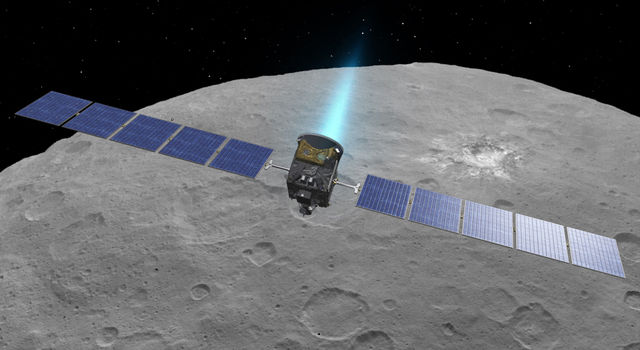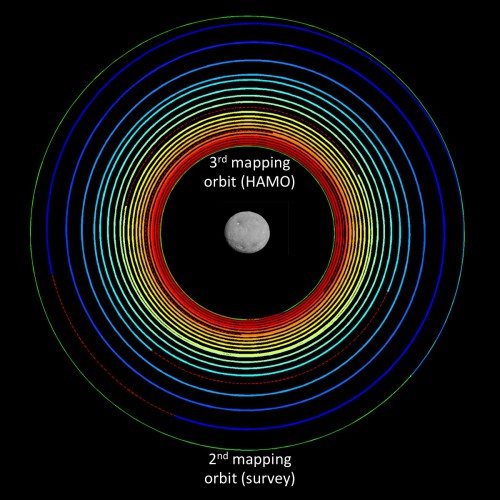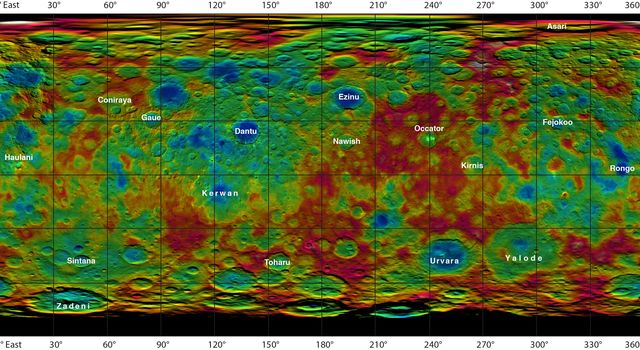
“Each time dawn appears, the mystery is there in its entirety.” — Rene Daumal
While astronaut Scott Kelly’s “Year in Space” mission helps researchers understand the effects of long-duration space travel on humans, 2015 continues to be a watershed year in the fields of planetary and cometary science. NASA’s New Horizons spacecraft recently completed the first-ever flyby of Pluto, while ESA’s Rosetta will soon observe a comet at perihelion from the vantage point of an orbiting spacecraft for the first time in spaceflight history. Juno continues its journey to Jupiter, while the Curiosity rover keeps returning incredible science results from Mars’ surface three years after its much-celebrated touchdown.
… But we’re leaving out one essential current mission: NASA’s Dawn spacecraft, the first to employ a unique ion propulsion system, also has earned its place in the planetary science canon.
Having already surveyed the asteroid Vesta, in March it arrived at a foreign world, the dwarf planet Ceres. Dawn has completed its second survey orbit and has returned color maps detailing its features. The spacecraft currently is en route to its third science orbit, which has been designated the High Altitude Mapping Orbit (HAMO).
Orbital ATK And JPL Work Out Ion Thruster Issues, Mission On Course
Dawn is currently transiting to HAMO, reducing its altitude from 2,700 miles to 900 miles above the dwarf planet, and is scheduled to arrive there on Aug. 18. The mission ran into some snags recently as one of its ion engines ran into some issues. According to the spacecraft’s manufacturer, Orbital ATK, “The mission stood down for two weeks while NASA’s Jet Propulsion Laboratory (JPL) and Orbital ATK teams worked through an issue that surfaced June 30 for one of the gimbals for an ion thruster.” Dawn is the first spacecraft to use an innovative ion propulsion system.

Orbital ATK explained how this system “gently, but persistently” boosts the spacecraft through space: “This is accomplished by ionizing the xenon gas, accelerating it with an electric field and expelling the ions through one of the craft’s three thrusters at high velocity. The thrust provided is roughly equivalent to the pulling power of a large beetle. However, given the vacuum of space, this small force, applied over a long period of time, really adds up. Over the course of the mission, Dawn has changed its velocity by the equivalent of over 24,000 mph (10.8 km/sec), using about 865 lbs (393 kg) of xenon fuel.” The Dawn mission, which launched aboard a Delta 7925-H launch vehicle on Sept. 27, 2007, from Cape Canaveral Air Force Station’s Complex 17B, reached Vesta in 2011 and Ceres this year thanks to this unconventional propulsion method. (Another unconventional propulsion method, solar sails, was addressed this year with The Planetary Society’s latest LightSail deployment.)
Early in its five-week trek to HAMO, ion thruster #3 developed an issue with its gimbals, which affects the direction the spacecraft is “pointed.” Dawn entered into a “safe mode,” designed to protect the ship in case it encounters a potentially harmful situation. Controllers switched to ion engine #2, and after some observation Dawn was observed to be in fine fitness, with spacecraft systems and hardware otherwise in good health. Later in the fall Dawn will transition to its final orbit, designated as the Low Altitude Mapping Orbit (LAMO), where it will stay through the mission’s end.
Second Survey Orbit Reveals Surprising Peaks And Depths
While New Horizons has captured much of the public’s attention this past month, the first spacecraft to reach a dwarf planet in spaceflight history was Dawn. On March 6 it arrived at Ceres, which has a diameter of 584 miles (940 kilometers). Despite its small size, it showed itself to have possible ongoing geological activity. In April, a previous AmericaSpace story stated: “[A] color map from Dawn reveals a highly diverse body that was active in the past and may still be active today, researchers revealed when [an early] map was unveiled at a science session at the 2015 General Assembly of the European Geosciences Union in Vienna, Austria. Images from Dawn’s framing camera show a highly cratered body replete with ‘differences in morphology and color’ spread across the surface, the researchers concluded.”
As Dawn spiraled closer to Ceres, it has revealed even more about the dwarf planet’s alien surface. New maps have been released as Dawn recently wrapped up its second “survey” science orbit, which according to NASA show “height differences between crater bottoms and mountain peaks as great as 9 miles (15 kilometers).” The dwarf planet has revealed itself to have diverse topographic features, including the crater containing much-discussed “bright spots.” NASA revealed this crater now has a name, Occator. The International Astronomical Union (IAU) recently released names for some of Ceres’ distinctive geological features.

Dawn science member Paul Schenk, a geologist at the Lunar and Planetary Institute in Houston, Texas, discussed what Ceres’ craters show researchers on Earth. “The craters we find on Ceres, in terms of their depth and diameter, are very similar to what we see on Dione and Tethys, two icy satellites of Saturn that are about the same size and density as Ceres. The features are pretty consistent with an ice-rich crust,” he related.
Ralf Jaumann, a member of Dawn’s science team who works for the German Aerospace Center, DLR, also underscored what the spacecraft’s findings mean for scientists. “The [newly named] impact craters Dantu and Ezinu are extremely deep, while the much larger impact basins Kerwan and Yalode exhibit much shallower depth, indicating increasing ice mobility with crater size and age,” he explained.
While researchers continue to pore over data from Dawn’s previous orbits, the spacecraft continues its trek to HAMO on target for an Aug. 18 arrival. According to NASA, from that vantage point the spacecraft (and watchers on Earth) will behold the dwarf planet at “unprecedented resolution.”
Please check back with AmericaSpace for more updates about the Dawn mission.
Want to keep up-to-date with all things space? Be sure to “Like” AmericaSpace on Facebook and follow us on Twitter: @AmericaSpace



